| Barbara Lane - Part 3 |
Richard Lavallee Dec 2020 |
| Click photos to enlarge |
By the end of the 1950's, our section of Barbara Lane had more or less settled
in to the neighborhood it would be until I left for college.
The Reinharts and Kenny Beals were gone, the Taillefers had moved away from
our trailer, the Shaner family were renting the house my father purchased from
the Petersens across the street. The Fords moved away and a crippled
man whom we called Gimpy and his mother lived in their trailer.
A different Petersen family moved in below where the Fords had been.
The Jensens moved into Al Day's house next to the Calkins family.
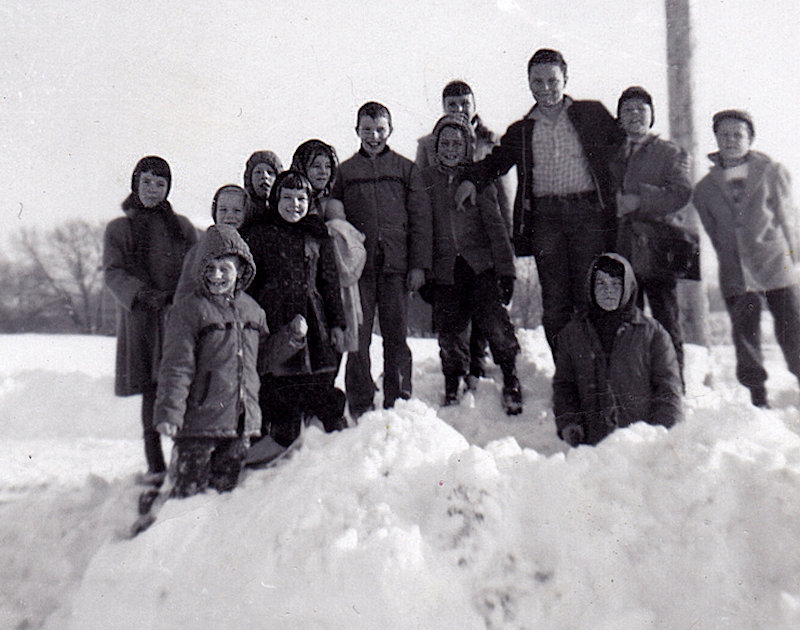 The
Jensens came from Michigan looking for work. Mr. Jensen wound up
working for Osier Well Drillers, the same company that employed Mr. Shaner.
Their oldest, Bill, was my age, and we hit it off right away. Bill was
like his Dad, Ralph Jensen. He was a happy-go-lucky kid with
a good sense of humor and we were best pals. My brother Gary was Ralph
Jr. "Butch's" age, so they tended to hang out. Butch was smarter
than Bill, but Bill & I got along better. Then came Mark.
Mark was a wild man. He was always clowning around, bouncing off the
walls. Then came Sally, a sharp-witted little princess who
hung out with my sisters, and finally, Janet Joyce Jensen, the baby.
A little sweetie.
The
Jensens came from Michigan looking for work. Mr. Jensen wound up
working for Osier Well Drillers, the same company that employed Mr. Shaner.
Their oldest, Bill, was my age, and we hit it off right away. Bill was
like his Dad, Ralph Jensen. He was a happy-go-lucky kid with
a good sense of humor and we were best pals. My brother Gary was Ralph
Jr. "Butch's" age, so they tended to hang out. Butch was smarter
than Bill, but Bill & I got along better. Then came Mark.
Mark was a wild man. He was always clowning around, bouncing off the
walls. Then came Sally, a sharp-witted little princess who
hung out with my sisters, and finally, Janet Joyce Jensen, the baby.
A little sweetie.
Photo left to right Marilyn Lavallee, Mark Jensen, Glory Ann
Shaner, Robin Shaner, Lorraine Lavallee, Wendy Calkins, Bill Jensen, Bruce
Secor, Brenda Secor, Dickie Petersen, Dickie Lavallee, Gary Lavallee, Eddy
Calkins
Next door lived Eddy and Wendy Calkins. Eddy was always
part of the gang, and so was Dicky Petersen, who lived between us and the Calkins.
We had enough kids to play softball or anything we could think of. Kickball,
bicycle tag, card games. Gary and I hung out at the Jensens's house
all the time. Mrs. Jensen - Shirley, was very easy going.
She would be in the house in her nightgown or a housecoat most any time of
day. I think there was always a bowl or two with a few soggy Cheerios
swimming in milk on the table every time. We could walk in the house
without knocking and no one thought it was rude. Shirley was a
great Mom. When Ralph got home from work we were usually back at our
house for dinner, but on weekends Ralph would stretch out in a lawn chair and
have a beer and laugh at whatever we were up to. Ralph bought things
that kept us busy trying to build go-carts. He bought an Allis-Chalmers
tractor and they had a huge garden in the back of their property, although
I'm not sure they did a lot of harvesting of the vegetables. It was a
project. We would take the tractor and pop wheelies with it. It
had a "thumb buster" crank start like old cars. Years
later my sister Marilyn would own one just like it to mow her 4 acres of lawn,
which took all afternoon.
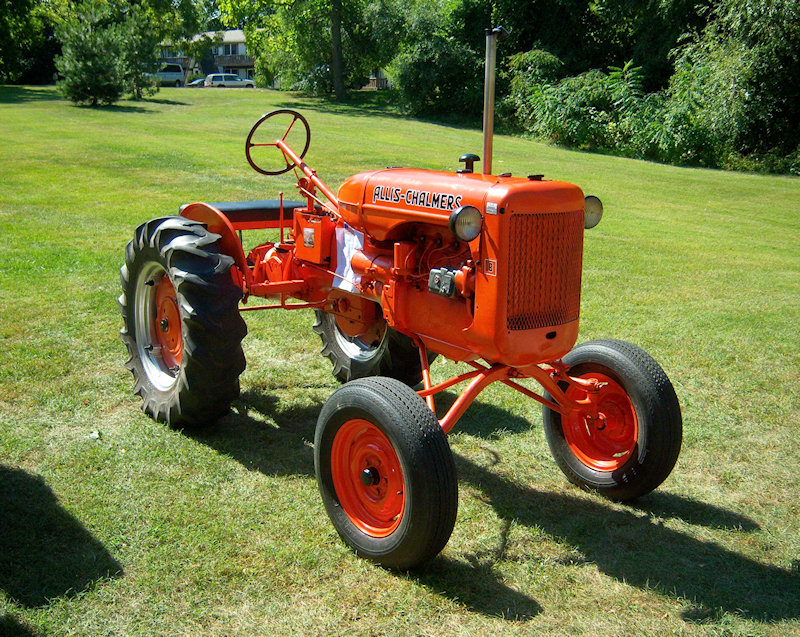 Then
Ralph brought home a mini-bike with a Briggs & Stratton engine and a centrifugal
clutch & belt drive. No shifting. Ralph and Shirley and Bill
were so generous with all their stuff. Bill would let me take the
mini-bike all over the place on Melvin's farm, around the Pit and the Pond
What a blast. When Bill got a little older he would buy cars from the
wreckers that were still running for $10 and he would drive them around the
Old Farmer's fields on a track he wore into the dirt. The cars would run
for a while and then throw a rod or something and we would shove them in the
hole in the ground where the cellar used to be that the Ford girl's husband
built. We learned some auto mechanics along
the way.
Then
Ralph brought home a mini-bike with a Briggs & Stratton engine and a centrifugal
clutch & belt drive. No shifting. Ralph and Shirley and Bill
were so generous with all their stuff. Bill would let me take the
mini-bike all over the place on Melvin's farm, around the Pit and the Pond
What a blast. When Bill got a little older he would buy cars from the
wreckers that were still running for $10 and he would drive them around the
Old Farmer's fields on a track he wore into the dirt. The cars would run
for a while and then throw a rod or something and we would shove them in the
hole in the ground where the cellar used to be that the Ford girl's husband
built. We learned some auto mechanics along
the way.
The Jensen's house was at a low point on the road and the hill, and the Old
Farmer's drainage ditch which we called The Crick took a sharp right turn behind
the Jensen's and headed for the Cove, a spot on the Seneca River next to the
Railroad Trestle. Because of all the groundwater, the Jensen's
yard had two enormous cottonwood trees. In the spring the cottonwoods
would bloom and the flowers - the cotton - would cover their yard like someone
had ripped open a bunch of pillows, and the "feathers" got
into everything for a week or so, and since there was always all kinds of toys
and junk and "projects" it made a real mess.
It was all part of the crazy chaos of the Jensen's.
TV was always a big part of the Jensen experience. The Flinstones, Three
Stooges, Real McCoys and the Beverly Hillbillies were the top shows for us.
The more slapstick the better. . The girls were into Petticoat Junction,
which I couldn't stand, when Petticoat Junction or Green Acres came on it was
time to go outside and look for for something to do So lame. So
stupid. They were total ripoffs of the Hillbillies. TV was for
when it was too cold or nasty to play outside, although we did have an after-school
ritual that included Rocky& Bullwinkle, the Three Stooges,
and Popeye. Popeye was also a Saturday Morning requirement.
The best Popeyes were the 1930s & 40s Black & Whites, by the Fleischer
brothers, along with their longer color features of the same era like Ali-Baba,
Sinbad, and Aladdin. We had a local TV show hosted by Salty Sam
that featured Popeye cartoons and drawings sent in by kids of fictional Popeye
sidekicks like Joe the Hook and others invented by the host Salty Sam.
In the winter we would also watch Saturday shows like Hopalong Cassidy, the
Lone Ranger, Roy Rogers, The Little Rascals. Rin Tin Tin, My Friend Flicka,
Circus Boy (starring future Monkee drummer Mickey Dolenz) . Also Jungle
Boy, a show hosted by Andy Devine, & Tarzan.
Night time viewing was limited by our bed time of 9 PM, which meant I never
got to watch Gunsmoke unless I was visiting my cousins up North, which was
a real treat for both reasons. I always thought Dennis Weaver
(Chester) looked just like my Uncle Glenn - even to the limp. My
uncle didn't limp as bad as Chester, but he did limp a little, after an accident
where my grandfather's bull almost killed him. The bull caught my Uncle
unawares out in a field, trampled him, tore his clothes off, threw him over
a fence, and punctured a lung. When we visited Grandma & my cousins
up North I slept in Uncle Glenn's bed. He had pin curlers which the boys
then used to put a wave in their hair for the girls. I loved the way
Uncle Glenn's room smelled, and he had watches on his dresser that no longer
kept time. He would give me one of the old watches, which would become
a prized possession.
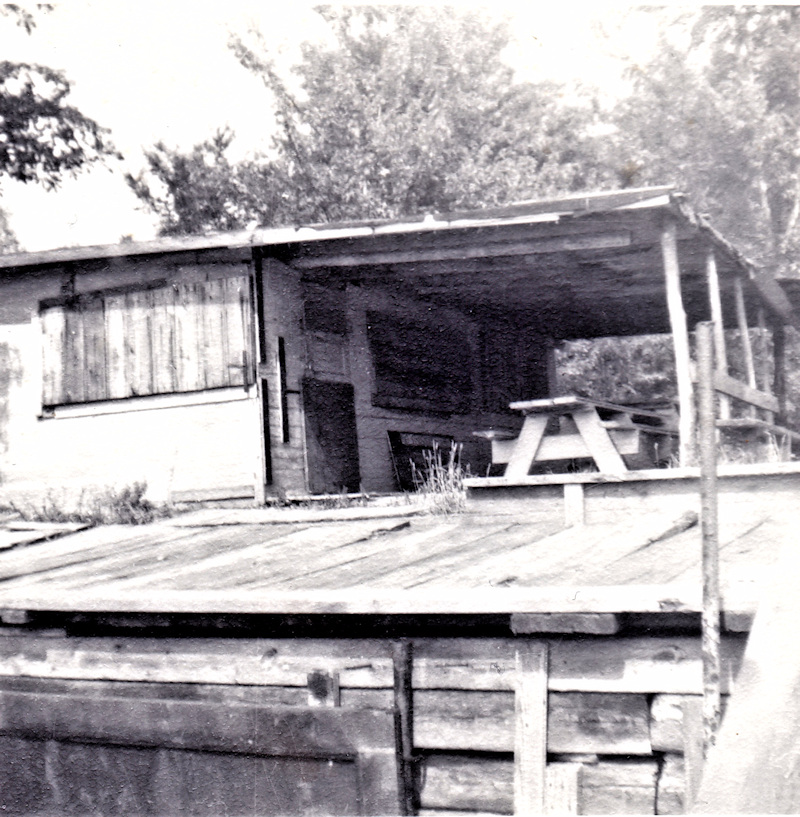 |
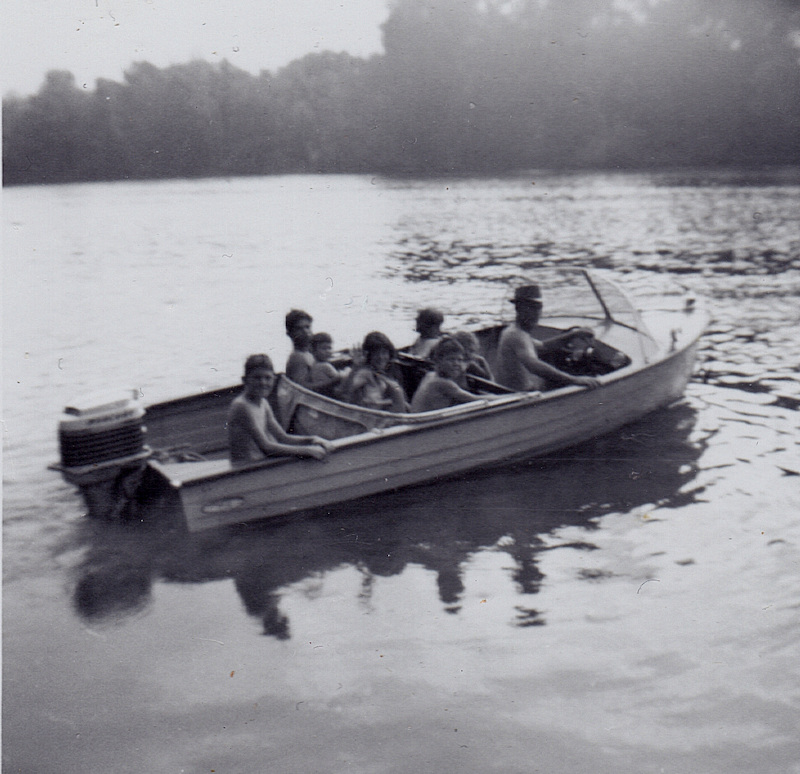 |
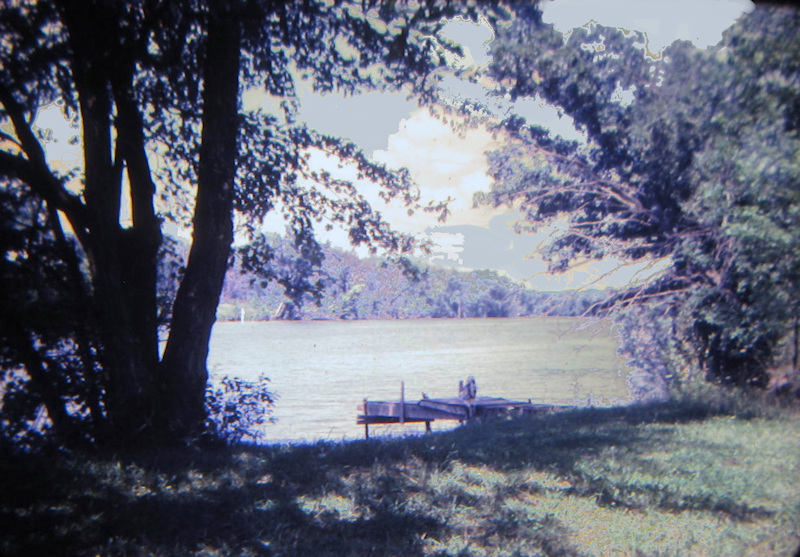
|
| The Trestle was just upstream & around the bend.. |
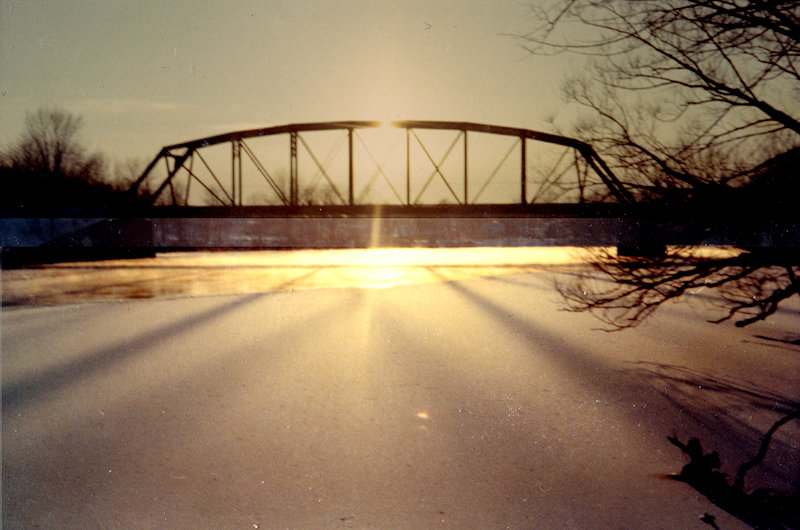 |
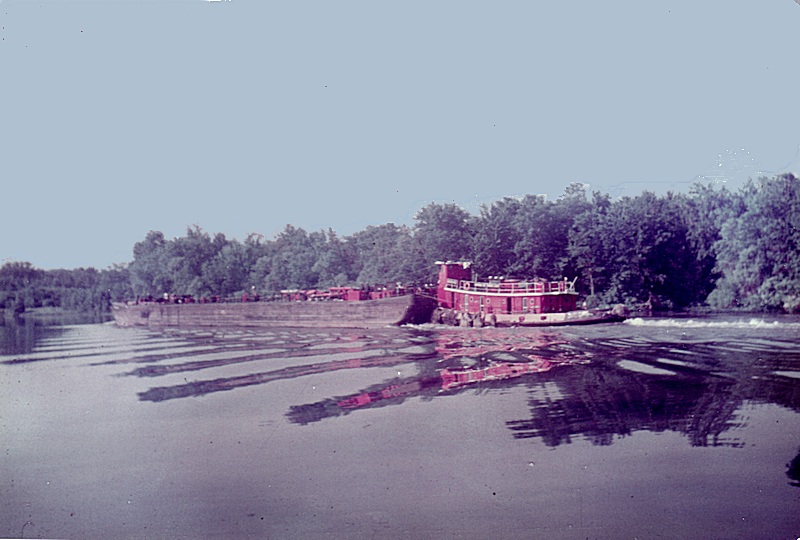 |
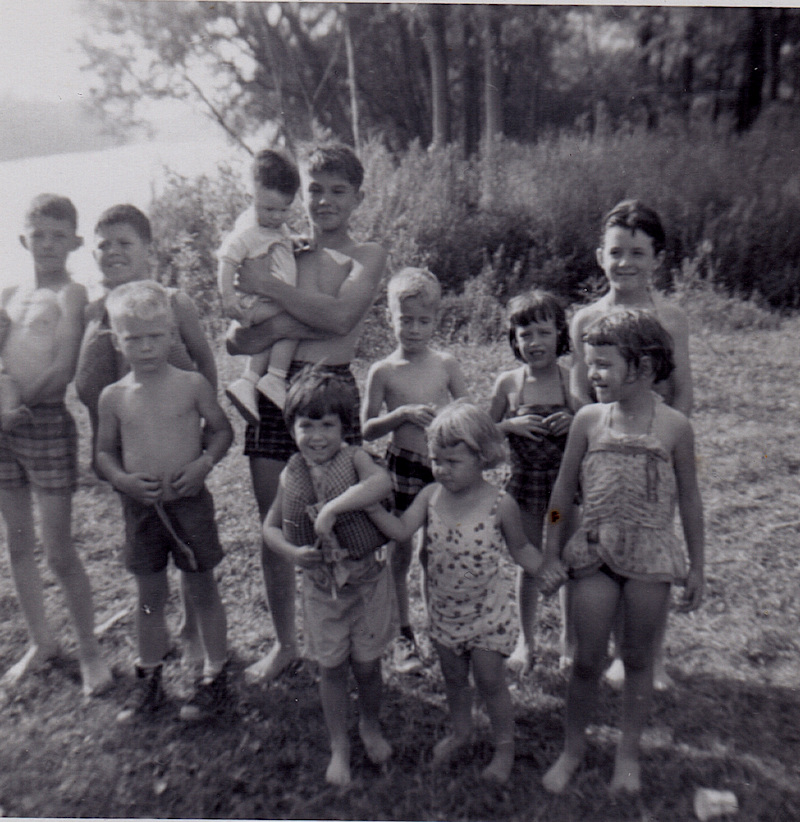 |
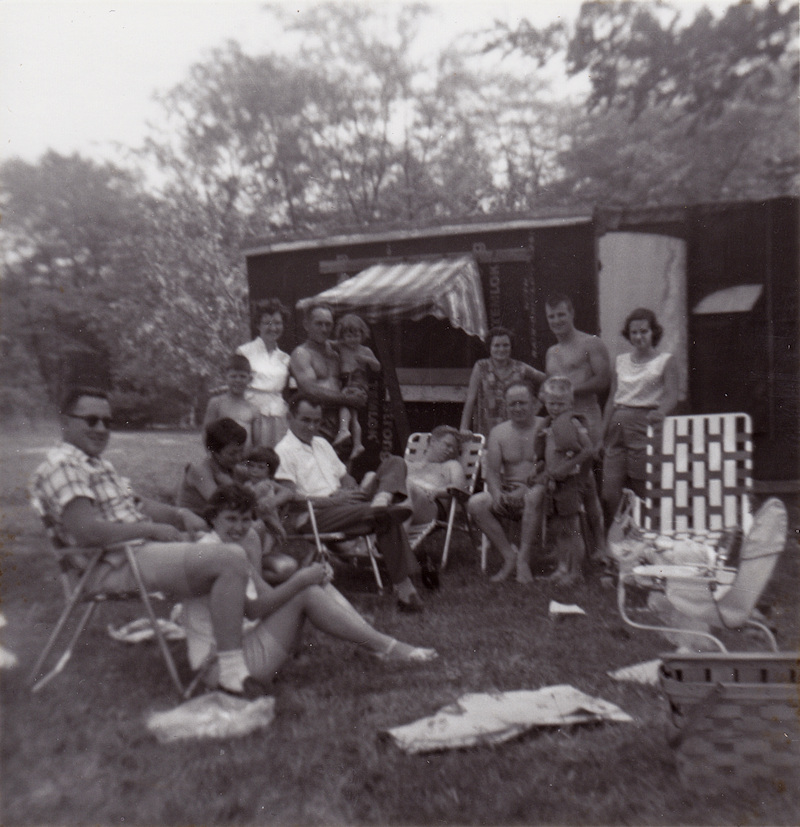 |
My favorite night time show was Perry Mason, a show I still enjoy today, along
with Gunsmoke. On Sunday evenings we always had to watch Lassie,
at my sister's insistence, and Gary and I would infuriate my sister by guessing
the plot every time, until she hollered and Dad put an immediate end to it.
Then Disney and Ed Sullivan.
It sounds like we watched a lot of TV, but it was really only about 2 hours
per day, which is nothing compared to today.
Bill & Butch were not the adventuresome type like Gary & me.
We loved to explore the forests and fields. The Pit and the Pond were
favorite spots. After Mac dug the Pond, my brothers and I were
quick to turn it onto a fishing pond. We had a little business
going where we sold night crawlers and minnows to fishermen. We had a
sign posted on the main road - "Worms - 2 cents" We also
sold crayfish and minnows when we could get them. We caught worms at
night with a flashlight. After a spring rain the nightcrawlers would
emerge to the surface to mate and forage, and with care & stealth we would
catch them and place them in a holding pen that we made by sinking the tub
of an old washing machine in the ground and filling it up with the black dirt
in the swamp at the back of our yard. We added coffee grounds which earthhworms
love. When we needed worms to sell we would easily dig them up
from the sunken tub. We caught minnows by walking up the creeks with
a seine - which is a square net with broom handles sewn to two sides.
One of us on each side holding the net we would walk up the stream and then
lift the net and catch the minnows and crayfish and keep them separately
in special buckets with holes which we kept in the creek. We took
minnows and stocked the Pond with them, but someone else did the same thing,
and they weren't careful to keep the carp minnows out, so although the Pond
soon became a good fishing hole, there were also carp in the pond as well.
Carp aren't good because they eat the eggs and small fish. The
Pond soon had catfish, bass, rock bass and sunfish.
The land around the Pond we called The Pit. It was raw,
gravelly soil that had had all the topsoil stripped away by Mac's gravel mining
operation, and for years not even weeds grew on it. It was
good for riding bicyles, except for the big pebbles which were cleared away
to make a path. Killdeer liked to nest there, because they hid their
eggs among the round stones. When we visited The Pit, the mother killdeer
would cry and pretend it had a broken wing to distract us from trying to find
the nest. After many years little poplar trees began to sprout
there.
Thirty yards or so away from The Pit was the Sand Pit, which was a naturally
occurring formation of rock flour left behind by the glaciers. Rock flour
is a super-fine sand powder ground up by the glacier. It is quite sterile
soil. almost pure silica, so nothing grew in it. For some reason Melvin
the farmer used it for a dump site, so it had old TVs and radios that fascinated
me with their colorful and complex circuits of resistors and capacitors.
The vaccum tubes made great pretend rocket ships, like Flash Gordon's, with
the little pins at the base being the rocket engines. The sand pit was
at the edge of a Hemlock forest that had no brushy undergrowth - very unususal
for an eastern forest. It was like a big park under the tree
canopy - the sandy earth was open and it was very dark under the dense canopy.
One of the trees had a big vine growing up into it which we used as a swinging
vine, like Tarzan.
The Camp
Most of our fishing was done in the Seneca river, which was just
down the road. . My Dad purchased a lot right on the river and
we built a dock so we could launch my Dad's boat. Later
my Dad purchased the adjoining lot - this was The Camp. It already had
a cabin and a much nicer dock - but it didn't have the boat ramp that allowed
us to launch the boat, so it was necessary to have both river lots.
The Camp was the scene of many adventures on the Seneca Rver. We
went swimming in the river once the water temperature had warmed up in early
summer. We fished from the shore, and when Dad got his first boat
he took us fishing in it. There are many varieties of fish in the river
- catfish, bullhead, bass, sunfish, walleyed pike, sheepshead, northern pike,
even the elusive muskellunge - as well as turtles and an occasional water snake,
which was always scary to see. And of course the ubiquitous carp,
a stocky, muscular fish that could snap your fishing line with ease, but which
we were told were not good to eat because they were bottom feeders.
In the springtime the ice would melt off the river and that was
when we would find boats that had been torn off their moorings by the ice and
had drifted downstream to where we would find them. On our
side of the river there wasn't another house or camp on the river all the way
to Baldwinsville, two miles away, so there was no way to find the boats' owners.
We found a boat every year or two and used them as rowboats with oars
we found as well. Once I found a little model sailboat made of wood.
It had a metal keel and the hull had been scorched a little. I fashioned
a mast and a boom with wood dowels, and made a cloth sail.
I sailed the little sailboat across the Pond. By fixing the
boom at an angle the little boat would tack across the pond, where I would
pick it up and sail it back across. One year Gary found
a flat-bottomed rowboat on the river with outrigger pivots that allowed long
oars. Gary and I would send that rowboat flying down the river.
We didn't use the cabin much as kids. The door was kept locked,
and the windows had wood hatch covers hinged at the top which were lowered
and locked down. Inside, the camp had a kitchen with a propane
stove, and three rooms which served as a living room and two bedrooms. There
was an old crank phonograph with a steel needle and a couple of old 78rpm records.
One of the records had an oriental-theme jazz recording with a tune which I
can still recall today. There was a hand pump out in the yard, no
running water & no electricity. But as I say, the cabin
did not see much use until years later, when it became my home.
This stretch of river had no other cabins or houses, so it was like
a wilderness. The forest grew right up to the river's edge.
Occasionally a dead tree dies and falls over into the river.
The only sign of civilization were the lantern bouys that were used by the
tugboat-barge captains to navigate the transport of heavy freight goods like
coal up and down the RIver - which along our stretch of the Seneca RIver is
also part of the Erie Canal. So at some point back in the mid 1800s where
our Camp stood there were towpaths and mules pulling the barges up and down
the river. But now the big diesel tugboats pushed the barges.
You would see one every day or so, but you would first hear them approaching
around the bend, and then you would see the river level drop at the edge, and
the water would speed up, before you ever saw the barge.
The tugboat and barge push a huge volume of water ahead of them in a wave,
and the barge takes up so much of the river's width that the water has to rush
around it to get behind the tugboat. For some reason this bow wave actually
causes the water to recede in front of it, and then swell when the barge is
very near, and then level out again after it passes.
My older brother taught me how to swim at The Camp, by making a "cannonball"
holding my knees to my chest in shallow water, holding my breath, and letting
myself sink and then bob back up to the surface. Once I knew I
could float, I was no longer afraid of the water and soon I was swimming.
A year or so earlier my Dad had tried to make me swin by throwing me in the
water. Being a skinny kid I sank right away and was terrified of the
water until my brother helped me overcome my fear.
The Camp also came with a floating dock made consisting of a wood
deck supported 55-gallon drums. It had a diving board on it. Gary
and I would dive off the dock and swim across the river under water - probably
100 feet or so. We were all good swimmers from swimming early every day
in the river. A few times we had a family picnic and my aunts
and uncles and cousins on my Dad's side came and
we roasted hot dogs and hamburgers and all the kids went swimming.
We also had family picnics at other places, like my Dad's brother Uncle Gil's
farm in Jack's Reef, at Owasco Lake and other Finger Lakes. Some years
my Dad's union, The United Auto Workers, had a picnic. The Union also
sometimes had a big Christmas party and we all got presents- I got a big model
of a B-17 bomber that was one of my favorite presents ever.
In winter the river freezes over, but it's always very risky to walk on the
ice because river levels rise and fall and river currents result in big changes
in ice thickness. The ice always pulls the dock loose from its supports
, so we had to dismantle the dock every year and bring it ashore.
In winter the Camp was abandoned but my brother and I would occasionally check
it out. This brings me again to the subject of winter, which I
will explore in the next chapter.
 The
Jensens came from Michigan looking for work. Mr. Jensen wound up
working for Osier Well Drillers, the same company that employed Mr. Shaner.
Their oldest, Bill, was my age, and we hit it off right away. Bill was
like his Dad, Ralph Jensen. He was a happy-go-lucky kid with
a good sense of humor and we were best pals. My brother Gary was Ralph
Jr. "Butch's" age, so they tended to hang out. Butch was smarter
than Bill, but Bill & I got along better. Then came Mark.
Mark was a wild man. He was always clowning around, bouncing off the
walls. Then came Sally, a sharp-witted little princess who
hung out with my sisters, and finally, Janet Joyce Jensen, the baby.
A little sweetie.
The
Jensens came from Michigan looking for work. Mr. Jensen wound up
working for Osier Well Drillers, the same company that employed Mr. Shaner.
Their oldest, Bill, was my age, and we hit it off right away. Bill was
like his Dad, Ralph Jensen. He was a happy-go-lucky kid with
a good sense of humor and we were best pals. My brother Gary was Ralph
Jr. "Butch's" age, so they tended to hang out. Butch was smarter
than Bill, but Bill & I got along better. Then came Mark.
Mark was a wild man. He was always clowning around, bouncing off the
walls. Then came Sally, a sharp-witted little princess who
hung out with my sisters, and finally, Janet Joyce Jensen, the baby.
A little sweetie. 






